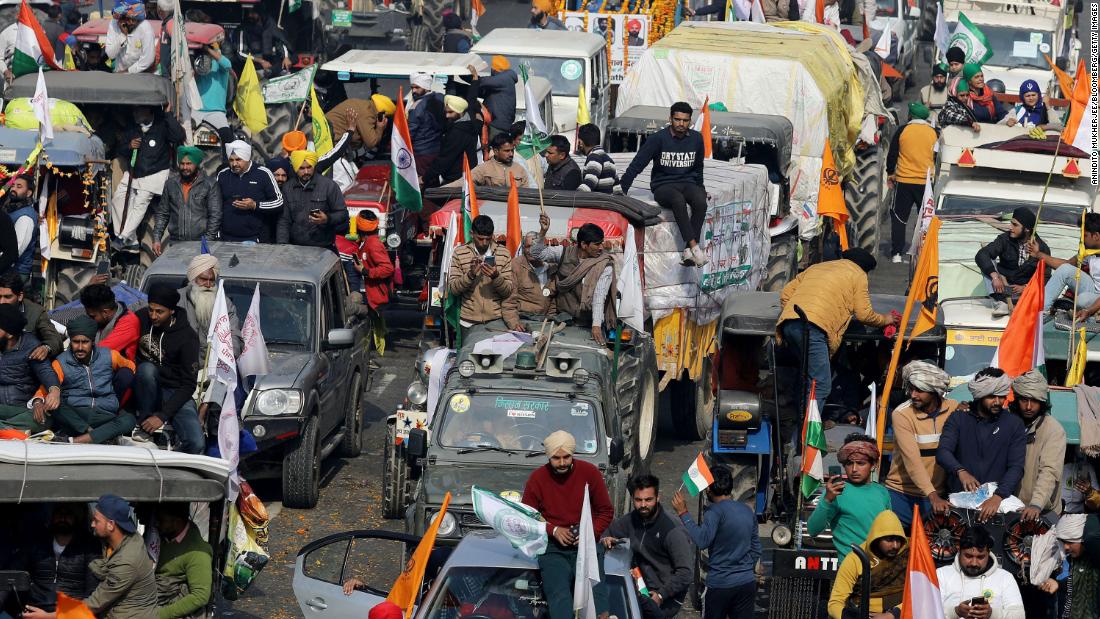
Tear gas and flashing blasts were seen in live streams from the city streets as police stopped crowds of protesters in tractors and on foot from breaking through barricades. Police as well as protesters were spotted in the streets with large sticks.
Many of the farmers, who had decorated their tractors with colorful flags, including the flag of India and various farmers’ unions, had been camping in protest on the outskirts of the capital for more than two months. Others, including young farmers from the northern states of Haryana, Uttar Pradesh, Punjab and Rajasthan, had gathered at the border in recent days in time for the planned Republic Day march in India.
Police used tear gas and batons against protesters outside the Delhi police station and in two adjacent parts of the city when some farmers broke through barricades, protesters said Tuesday.
“Tear gas and batons were used outside the Delhi police station, protesters also attacked the police buses stationed there,” said Paramjeet Singh Katyal, a spokesman for Samyukt Kisan Morcha, the umbrella group representing the farmers’ unions.
“We’ve broken the barricades, we’ve got our tractors, people are marching, some of the leaders are on horseback too … thousands of farmers have already reached the capital,” Katyal said.
At the Ghazipur border between Delhi and Uttar Pradesh, police used tear gas and batons to push back about 2,000 protesters, and on Tuesday morning tear gas was also used at the Singhu border between Delhi and Haryana, Ashutosh Mishra, a spokesman for All, said. India Sangharsh Coordination Committee, one of the unions leading the protests.
Although police had authorized farmers to hold a tractor meeting in Delhi, they had placed a maximum of 5,000 tractors, according to Mishra. However, more than 200,000 tractors were mobilized, with many young people coming from neighboring states, said Darshan Pal, president of the Krantikari Kisan Union, one of the many leaders of the protests.
A Delhi police spokesman, Anil Mittal, said they had no explanation about the skirmishes, saying only “we just asked the protesters to keep the peace”.
For decades, the Indian government has offered farmers guaranteed prices for certain crops, providing long-term assurance that they could theoretically make investments for the next crop cycle. The new agricultural laws, first passed by Modi’s government in September, allow farmers to sell their goods to anyone at any price – giving them more freedom to do things like sell directly to buyers and sell to other states.
But farmers argued that the new rules would make them worse by making it easier for companies to exploit farm workers, and by helping big companies to keep prices down. In contrast, while farmers could sell crops at higher prices when the demand is there, they might struggle to meet the minimum price in years when there is too much supply on the market.
The laws were so controversial because agriculture is the main source of income for about 58% of India’s 1.3 billion population, and farmers have been advocating for an increase in minimum guaranteed prices for years. They are the largest electoral bloc in the country, making agriculture a central political issue.
There have been sit-ins along each of New Delhi’s three borders. Farmers have blocked roads and set up makeshift camps, some sleeping on the road or in their tractor. They came from different states to participate in the massive protests, sometimes clashing with the police.
The government has held 11 rounds of talks with leaders of more than 30 peasant unions who oppose the laws, but the talks have led nowhere.
Putting up the pressure, protesters on Tuesday and the three routes into the city designated by Delhi police said they planned to march at six points at the city limits as well as in the northern states of Haryana, Rajasthan and Uttar Pradesh, according to Yogendra Yadav, a leader of the peasant protests.
Farmers’ unions also plan to march to parliament on Feb. 1, the day the parliament will hold its budget session, Yadav said.
To keep the crowd in check, Delhi traffic police have created detours along several major highways and main roads in the city, and the metro has closed exits from at least 15 stations close to protest sites.

